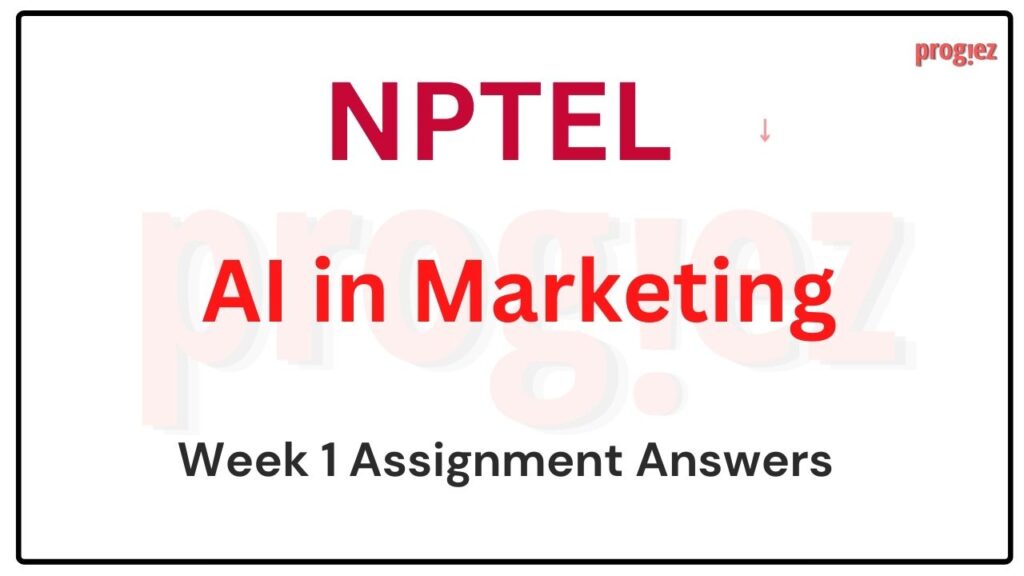AI in Marketing Nptel Week 2 Assignment Answers
Are you looking for AI in Marketing Nptel Week 2 Assignment Answers ? You are here at right place for answers solved by our experts at Progiez.
Table of Contents
AI in Marketing Nptel Week 2 Assignment Answers (Jan-Apr 2025)
Course Link: Click Here
1) How does Artificial Intelligence (AI) enhance operational efficiency in the value chain?
Options:
[a] By eliminating customer segmentation.
[b] By reducing dependency on traditional 4Ps of marketing.
[c] By automating repetitive tasks and optimizing inventory flow.
[d] By replacing strategic marketing with tactical marketing.
2) Nike’s implementation of augmented intelligence to design customized shoes is an example of which AI-driven value creation form?
Options:
[a] Process Efficiency.
[b] Process Enhancement.
[c] Product or Service Innovation.
[d] Customer Value Optimization.
AI in Marketing Nptel Week 2 Assignment Answers (Jan-Apr 2025)
3) Which limitation of deep learning makes it unsuitable as a basis for developing general intelligence?
Options:
[a] Lack of computational power.
[b] Limited ability to recognize patterns.
[c] Insufficient understanding of causation.
[d] Dependence on pre-labeled data.
4) What key capability is essential for creating a modern data foundation in AI-driven businesses?
Options:
[a] Exclusive reliance on big data.
[b] Integration of siloed data with cloud-based tools.
[c] Prioritization of real-time data over historical data.
[d] Elimination of human involvement in data governance.
5) What is the primary purpose of “digital decoupling” in IT architecture?
Options:
[a] To integrate legacy systems with modern technologies gradually.
[b] To replace all existing systems with cloud-based solutions instantly.
[c] To automate customer interactions entirely using AI.
[d] To eliminate the use of traditional data processing methods.
6) What stage of human-machine interaction focuses on machines adapting to humans?
Options:
[a] Machine-Centric.
[b] Collaborative.
[c] Human-Centric.
[d] Automation-Centric.
7) Which of the following best describes the difference between stand-alone and integrated AI applications?
Options:
[a] Stand-alone applications require more data than integrated applications.
[b] Integrated applications are embedded within existing systems, unlike stand-alone applications.
[c] Stand-alone applications handle complex customer interactions, whereas integrated applications automate tasks.
[d] Integrated applications are limited to customer-facing roles, unlike stand-alone applications.
8) A company is new to AI adoption and wants to start small. Which approach should it initially pursue?
Options:
[a] Build or buy a machine-learning-based integrated app.
[b] Implement an AI-driven marketing mix analysis.
[c] Use a stand-alone, noncustomer-facing task automation app.
[d] Develop advanced predictive analytics tools.
9) What kind of inferential thinking is AI most suited for, according to Judea Pearl’s Ladder of Causation?
Options:
[a] Counterfactuals.
[b] Intervention.
[c] Association.
[d] Creative simulations.
10) A firm wants to leverage AI for competitive advantage across industries. What approach should the firm prioritize, as suggested by the document?
Options:
[a] Focus on deep specialization within traditional industry boundaries.
[b] Create connections across industries and leverage data flows through networks.
[c] Rely solely on traditional resources and internal expertise.
[d] Build AI applications exclusively for internal data analysis.
AI in Marketing Nptel Week 2 Assignment Answers (Jan-Apr 2025)
For answers or latest updates join our telegram channel: Click here to join
These are AI in Marketing Nptel Week 2 Assignment Answers
More Answers of AI in Marketing Nptel: Click here
For answers to additional Nptel courses, please refer to this link: NPTEL Assignment

